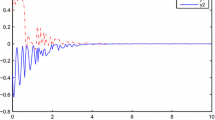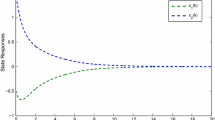Abstract
For the first time, this paper investigates the global asymptotic stability of stochastic fuzzy neural networks with mixed delays and Markovian jumping under impulsive perturbations in mean square. The mixed delays include time-varying delay and continuously distributed delay. By using stochastic analysis method, linear convex combination technique, Jensen integral inequality and the free-weight matrix method, a novel sufficient condition is derived to ensure the global asymptotic stability of the equilibrium point of the considered networks in mean square. The proposed result, which is expressed in terms of linear matrix inequalities, can be easily checked via Matlab software. Finally, a numerical example is given to demonstrate the effectiveness and less conservativeness of our theoretical results over existing literature.


Similar content being viewed by others
References
Arnold L (1972) Stochastic differential equations: theory and applications. Wiley, New York
Balasubramaniam P, Vembarasan V (2011) Robust stability of uncertain fuzzy BAM neural networks of neutral-type with Markovian jumping parameters and impulses. Comput Math Appl 62(4):1838–1861
Gu K (2000) An integral inequality in the stability problem of time-delay systems. In: Proceedings of 39th IEEE conference decision and control, Sydney, Australia, pp 2805–2810
Haykin S (1994) Neural networks. Prentice-Hall, New Jersey
Han W, Liu Y, Wang L (2012) Global exponential stability of delayed fuzzy cellular neural networks with Markovian jumping parameters. Neural Comput Appl 21:67–72
He C (2014) Approximation of polygonal fuzzy neural networks in sense of Choquet integral norms. Int J Mach Learn Cyber 5(1):93–99
Li X, Rakkiyappan R, Balasubramaniam P (2011) Existence and global stability analysis of equilibrium of fuzzy cellular neural networks with time delay in the leakage term under impulsive perturbations. J Franklin Inst 348:135–155
Lin D, Wang X (2010) Observer-based decentralized fuzzy neural sliding mode control for interconnected unknown chaotic systems via network structure adaptation. Fuzzy Sets Syst 161(15):2066–2080
Lin D, Wang X, Nian F, Zhang Y (2010) Dynamic fuzzy neural networks modeling and adaptive backstepping tracking control of uncertain chaotic systems. Neurocomputing 73(16–18):2873–2881
Liu Z, Zhang H, Wang Z (2009) Novel stability criterions of a new fuzzy cellular neural networks with time-varying delays. Neurocomputing 72:1056–1064
Mao X (2002) Exponential stability of stochastic delay interval systems with Markovian switching. IEEE Trans Autom Contr 47(10):1604–1612
Poznyak AS, Sanchez EN (1995) Nonlinear systems approximation by neural networks: Error stability analysis. Intell Automat Softw Comput Int J 1:247–258
Tang Y, Fang J, Miao Q (2009) On the exponential synchronization of stochastic jumping chaotic neural networks with mixed delays and sector-bounded non-linearities. Neurocomputing 72:1694–1701
Tong S, Li Y, Li Y, Liu Y (2011) Observer-based adaptive fuzzy backstepping control for a class of stochastic nonlinear strict-feedback systems. IEEE Trans Syst Man Cyber B 41(6):1693–1704
Tong S, Wang T, Li Y, Chen B (2013) A combined backstepping and stochastic small-gain approach to robust adaptive fuzzy output feedback control. IEEE Trans Fuzzy Syst 21(2):314–327
Yang Y, Wang G, Yang Y Parameters optimization of polygonal fuzzy neural networks based on GA-BP hybrid algorithm. Int J Machine Learn Cyber. doi:10.1007/s13042-013-0224-y
Yang T, Yang L (1996) The global stability of fuzzy cellular neural networks. IEEE Trans Circ Syst 43(10):880–883
Yuan C, Lygeros J (2005) Stabilization of a class of stochastic differential equations with Markovian switching. Syst. Control Lett. 54:819–833
Zhang Y, Yue D, Tian E (2009) New stability criteria of neural networks with interval time-varying delay: a piecewise delay method. Appl Math Comput 208:249–259
Zhou W, Tong D, Gao Y, Ji C, Su H (2012) Mode and delay-dependent adaptive exponential synchronization in \(p\)th moment for stochastic delayed neural networks with Markovian switching. IEEE Trans Neural Netw Learn Syst 23(3):662–668
Author information
Authors and Affiliations
Corresponding author
Additional information
This work was supported by the National Natural Science Foundation of China 61034005, 61074073, 61273022, Program for New Century Excellent Talents in University of China (NCET-10-0306), and the Fundamental Research Funds for the Central Universities under Grants N110504001 and N100104102.
Rights and permissions
About this article
Cite this article
Zheng, CD., Zhang, Y. & Wang, Z. Novel stability condition of stochastic fuzzy neural networks with Markovian jumping under impulsive perturbations. Int. J. Mach. Learn. & Cyber. 7, 795–803 (2016). https://doi.org/10.1007/s13042-014-0298-1
Received:
Accepted:
Published:
Issue Date:
DOI: https://doi.org/10.1007/s13042-014-0298-1




